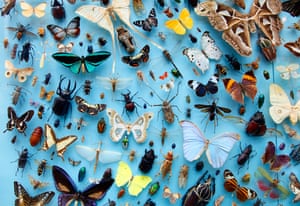Glow-worm numbers have plunged by three-quarters since 2001, research in England has revealed, with the climate crisis a clear factor.
The larvae feed on damp-loving snails, and increasingly hot and dry summers mean fewer prey and a greater risk of glow-worms becoming desiccated.
Some of the 19 sites studied across Essex are on nature reserves. The data there showed that clearing scrub and coppicing woods to open up ground helped offset glow-worm losses, indicating that conservation action is possible.
Glow-worms are small beetles and they exist in small patches across the UK. The females glow green to attract mates. They are wingless, making it hard for them to rebuild lost populations.
“Glow-worms were thought to be declining, and probably for several decades now, but there was no hard evidence,” said Tim Gardiner, of the Environment Agency, who led the research. “We have shown a big decline, and at many different sites around Essex. The changing climate has undoubtedly played a role.”
This is the first study to provide hard data on long-term changes in the glow-worm populationThe research, published in the journal Insect Conservation and Diversity, used data collected by citizen scientists during nighttime walks in June, July and August each year. “A lot of people are just recording one or two glow-worms when they go out,” Gardiner said.
The scientists accounted for changes in weather and the earlier emergence of the glow-worms as the climate heats up to calculate the trend over time. “If they decline like they have declined for the last 18 years, then in another 18 years there are going to be a lot more [local] extinctions,” said Gardiner.
Scientists warned in February that “fates of humans and insects are intertwined“, with the huge declines reported in some places only the “tip of the iceberg”. They acknowledge that little is known about most of the estimated 5.5 million insect species but said enough was understood to warrant immediate action.
Widespread insect declines threaten a “catastrophic collapse of nature’s ecosystems“, with dire consequences for humanity, some scientists have said.
Gardiner emphasised the intrinsic wonder of glow-worms. “I still remember when I saw my first one. It was just magical, and every summer I still get a pang of excitement on seeing the first one. Wouldn’t it be sad if there weren’t these things any more?”
The glow-worm research was one of a dozen studies published in a special issue of Insect Conservation and Diversity. Many report declines in some – but not all – insects.
In the US, scientists compiled sightings of the endangered Poweshiek skipperling butterfly from 1872 to now, showing that its geographic range has shrunk dramatically over time. Evidence from 217 sites shows the butterfly was historically common across the prairies of the upper mid-western US. But populations declined rapidly in the past 20 years as habitat was destroyed, and the butterfly is now extinct at all but five locations.
A 20-year study of a threatened flightless longhorn beetle at 13 sites in Switzerland, France and Germany recorded a fall in abundance of 90%, with the intensification of farming the main likely cause.

Researchers in the UK using light and suction traps recorded a 30% fall in moth abundance between 1969 and 2016, but found aphid populations remained level. In the Netherlands, light and pitfall traps found declines in abundance of 40-60% among moths, beetles and caddisflies between 1997 and 2017 , but true bugs, mayflies and lacewings did not show similar changes.
Prof Raphael Didham, of the University of Western Australia, who edited the special issue of the journal, said: “The problem is clearly global in extent, but the solutions needed are going to be many-fold and range from local individual choices to regional policies that reduce the intensity of human impacts on the environment, and global commitments to maintaining insect biodiversity.”
But he said the available data did not in itself constitute evidence for a sudden and catastrophic collapse of all insect populations. “In fact, we need to be equally worried about some examples of insect population increases as well, such as new incursions of invasive species, or cyclical pest outbreaks, and geographic range expansions due to climate change that could disrupt sensitive natural ecosystems,” Didham said.
On the plight of glow-worms in England, Gardiner said: “People should visit their local sites and become a champion for glow-worms. They’re not legally protected and by the time they become legally protected, it may be too late.”